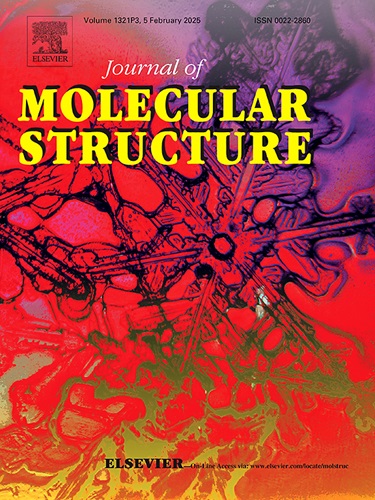Structural regulation and electrocatalytic hydrogen evolution reaction performances of nickel(II) coordination polymers based on benzimidazole-N-pyridine and terephthalate
IF 4
2区 化学
Q2 CHEMISTRY, PHYSICAL
引用次数: 0
Abstract
Coordination polymer is a group of promising electrocatalysts for hydrogen evolution reaction (HER). Herein, two new nickel(II) coordination polymers (CPs), formulated as {[Ni2(bpbe)(terephthalate)2(H2O)3](H2O)3}n (1), {[Ni(bpbe)2(terephthalate)(H2O)2](H2O)8}n (2) (bpbe = bis(1-(pyridine-3-ylmethyl)-benzimidazole-2-ylmethyl)ether), were successfully synthesized by solvothermal method. Structural analysis shows that the CP 1 is a two-dimensional layered structure, while the CP 2 is a one-dimensional linear chain structure. The position and coordination mode of the carboxyl groups in terephthalate determine the formation of different one-dimensional chains. The electrocatalytic activity for HER of nickel(II) CPs were studied by preparing modified glassy carbon electrodes (NiCP-1∼2/GCE). The overpotential (η10298K) and Tafel slope (b 298K) are -632 mV and 159.4 mV·dec−1 for NiCP-1/GCE, -658 mV and 179.4 mV·dec−1 for NiCP-2/GCE, -941 mV and 277.9 mV·dec−1 for bare/GCE, respectively. The η10298K and b298K of NiCP-1∼2/GCE were significantly positive shifted and decreased compared with the bare/GCE, indicating that NiCP-1∼2/GCE have significant electrocatalytic activity and electrocatalytic HER activity order is NiCP-1/GCE > NiCP-2/GCE > bare/GCE, which is attributed to the difference in the skeleton structure of nickel(II) CPs, that is, the higher the dimension, the better the activity. This study offers a significant theoretical value for the application of non-noble metal coordination polymers in electrocatalysis.
苯并咪唑- n -吡啶-对苯二甲酸盐基镍(II)配位聚合物的结构调控及电催化析氢反应性能
配位聚合物是一类很有前途的析氢反应电催化剂。本文采用溶剂热法成功合成了两种新型镍(II)配位聚合物(CPs),分别为{[Ni2(bpbe)(对苯二甲酸酯)2(H2O)3](H2O)3}n(1)、{[Ni(bpbe)2(对苯二甲酸酯)(H2O)2](H2O)8}n (2) (bpbe =双(1-(吡啶-3-甲基)-苯并咪唑-2-甲基)醚)。结构分析表明,cp1为二维层状结构,而cp2为一维线性链状结构。对苯二甲酸酯中羧基的位置和配位方式决定了不同一维链的形成。通过制备改性玻碳电极(NiCP-1 ~ 2/GCE),研究了镍(II) CPs的电催化活性。NiCP-1/GCE的过电位(η10298K)和Tafel斜率(b 298K)分别为-632 mV和159.4 mV·dec−1,NiCP-2/GCE的过电位(η10298K)和Tafel斜率(b 298K)分别为-658 mV和179.4 mV·dec−1,bare/GCE的过电位(η10298K)和Tafel斜率(η 298K)分别为-941 mV和277.9 mV·dec−1。NiCP-1 ~ 2/GCE的η10298K和b298K较裸/GCE显著正移和降低,表明NiCP-1 ~ 2/GCE具有显著的电催化活性,电催化HER活性顺序为NiCP-1/GCE >;NiCP-2 / GCE比;裸/GCE,这是由于镍(II) CPs骨架结构的差异,即尺寸越高,活性越好。该研究为非贵金属配位聚合物在电催化中的应用提供了重要的理论价值。
本文章由计算机程序翻译,如有差异,请以英文原文为准。
求助全文
约1分钟内获得全文
求助全文
来源期刊

Journal of Molecular Structure
化学-物理化学
CiteScore
7.10
自引率
15.80%
发文量
2384
审稿时长
45 days
期刊介绍:
The Journal of Molecular Structure is dedicated to the publication of full-length articles and review papers, providing important new structural information on all types of chemical species including:
• Stable and unstable molecules in all types of environments (vapour, molecular beam, liquid, solution, liquid crystal, solid state, matrix-isolated, surface-absorbed etc.)
• Chemical intermediates
• Molecules in excited states
• Biological molecules
• Polymers.
The methods used may include any combination of spectroscopic and non-spectroscopic techniques, for example:
• Infrared spectroscopy (mid, far, near)
• Raman spectroscopy and non-linear Raman methods (CARS, etc.)
• Electronic absorption spectroscopy
• Optical rotatory dispersion and circular dichroism
• Fluorescence and phosphorescence techniques
• Electron spectroscopies (PES, XPS), EXAFS, etc.
• Microwave spectroscopy
• Electron diffraction
• NMR and ESR spectroscopies
• Mössbauer spectroscopy
• X-ray crystallography
• Charge Density Analyses
• Computational Studies (supplementing experimental methods)
We encourage publications combining theoretical and experimental approaches. The structural insights gained by the studies should be correlated with the properties, activity and/ or reactivity of the molecule under investigation and the relevance of this molecule and its implications should be discussed.
 求助内容:
求助内容: 应助结果提醒方式:
应助结果提醒方式:


